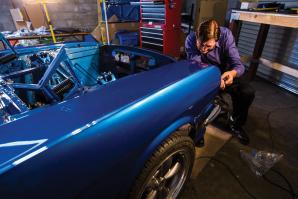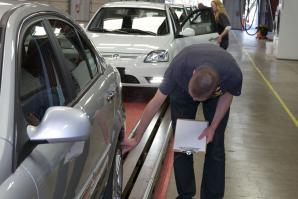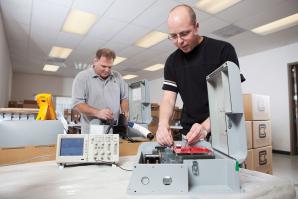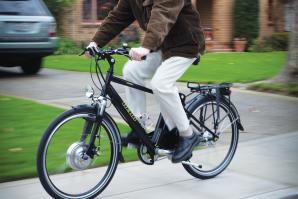Long before it was widely accepted, Sacramento attorney Mike Polis bought his first electric vehicle. He got started with a Toyota Prius, later upgraded to a Nissan Leaf and now drives a white Chevy Volt. On average, he saves more than $3,500 a year over his gas-powered counterparts, he can use the HOV lane as a single occupant and he charges his car for free at work.
Polis expected a free learning curve with purchase, but there were some lessons he didn’t count on. First was the battery degradation that reduced the range in his Leaf from 80 miles to 65 in just two-and-a-half years. And then there were plug squatters: EV owners who park, plug in and leave their car charging all day at the same station, leaving Polis’s battery empty for the drive home from work.
In the parking garage Polis uses, there are more electric
vehicles than charging stations, so figuring out how to
conveniently get back and forth without running out of power
has
taken on a new dimension.
“You do your best to plan, then you have to experiment with what works and what doesn’t and adjust as you go,” Polis says.
To combat plug squatting, building owners are empowering property and parking managers to come up with creative solutions. Kristin Abrahamson, a property manager for Hines, the company that owns the parking garage at 400 Capitol Mall where Polis works, came up with a solution to eliminate the squatters.
“We started utilizing our valet service to rotate the electric vehicles using our charging stations,” she says. The garage gets up to 12 electric vehicles parking in a day, but has only five charging stations. The complimentary valet service has always been offered as an amenity for the building’s tenants, but is required for those with electric vehicles needing a charge.
For trips that extend beyond an EV driver’s daily commute,
getting around takes a little more engineering and a lot more
planning. They need to know where the charging stations are
located, whether they are available and when their vehicle is
fully charged. For that, most EV owners turn to technology for
assistance. Campbell, Calif.-based ChargePoint provides a mobile
app and
website that allow drivers to check the location and availability
of 18,000 independently owned and operated charging stations;
make, change or cancel charging station reservations and get
status notifications sent to their smartphone during charging
sessions. PlugShare, a community-organized charging network,
offers consumers online tools for locating any of the 11,000
public and residential charging stations that are part of the
PlugShare community.
But not all charging stations are open to all EV owners; some are private. The Capital Region’s 2,000 electric vehicles are supported by 400 charging stations. Of those, 15 percent are private and another 10 percent are not part of an online network. Since the property owner controls how a station is administered, he or she can also determine whether a station is added to the network, whether a fee is charged or whether the station is private, giving them some leeway in how to deal with problems.
To give Hines tenants better access to the building’s charging stations, Hines has intentionally omitted its charging stations from the online network, even though the garage is public. “As much as we can, we want to make charging as convenient as possible for our tenants,” Abrahamson says.
Daniel Egan, a tenant who commutes from Wilton in his EV, has nothing but praise for the system. “With the valet service, there hasn’t been a day yet where I haven’t gotten a full charge while I was at work. ”
Polis has had a similar experience. “Now, instead of worrying about getting a charging spot, I just hand off my keys to the valet in the morning and know I will get some kind of charge before I head home.”
On average, most electric vehicles are fully charged after four
to 10 hours and can travel between 30 and 300 miles, depending on
the brand and battery setup. Peter Tiberini, operations manager
for Ace Parking, manages two downtown garages, including the 900
13th St. garage and a facility at 29th and K streets. To deter
squatting, he has added a nominal fee of $2.49 per hour to charge
up. It seems to be working. Tiberini has noticed a more
consistent rotation of
vehicles, which means more owners are using his stations. “We are
starting to see more of a need for additional charging stations
at the 13th Street site, so we’re working with our supplier to
add more,” he says.
Some EV owners are eschewing technology in favor of
grassroots strategies, banding together to create their own
underground communications networks. Dennis Albiani, vice
president for
California Advocates and the owner of a Chevy Volt, parks at the
Capitol Garage on Sacramento’s 10th and L streets, but says it’s
a battle to get there first and secure one of the four coveted
charging spots. Though he can charge for free, Albiani can only
stay a maximum of four hours before moving his car to avoid
ticketing or finding a nasty note from another EV owner who wants
in. So Albiani joined an email list of local owners who notify
one another when a station opens up.
“Right before I move my car, I’ll send out an email to the group, letting them know the spot will be available,” says Albiani. “It’s a pretty organic system, but it’s immediate and it works.”
Being able to charge up at work is important, but so is charging at home. To mitigate the concern of running out of power during a trip, the majority of EV owners are installing their own dedicated residential charging stations. While most electric vehicles can be plugged in anywhere, the output of electricity from the average 110 volt home outlet is slow, so many upgrade to a 240 volt system, which can charge up to ten times faster but costs $2,000 or more installed.
To maximize his charging output and minimize his electric bill, Polis has a wall connector and charger installed at his home plus solar panels on his roof. He received a federal credit for about 30 percent of the cost. “The system essentially pays for itself in about seven years in reduced electric costs,” Polis says, “so for me it was worth the investment.”
Although the average electric vehicle costs between $7,000 and $15,000 more than a gas-powered car, generous rebates and tax credits are big incentives that entice drivers to make the switch. The federal government offers up to $7,500 in tax credits and the state of California adds another $1,500 rebate. The Clean Vehicle Rebate Project also provides a $2,500 rebate to EV purchasers through the Center for Sustainable Energy.
“Without the tax credit and rebate, it would have been difficult to justify buying an electric vehicle,” Egan says.
With a little research and simple pre-planning, EVs can be a cost-effective and environmentally friendly way to get around, but owners should be ready to work with a relatively new support infrastructure that is still catching up with demand.
“Before I got my electric vehicle, I was very apprehensive,” Albiani says. “I wanted to see what type of paradigm change would happen in my life.” But after using a loaner vehicle for a week, arranged by the California Electric Transportation Coalition and his Chevy dealer, he “found that switching to an electric vehicle was really doable for the way I need to use it.”
Recommended For You

Cart & Driver
Electric golf cars ride the green in Placer County
The city of Lincoln has embraced an alternative mode of transportation — the neighborhood electric vehicle — and so has Sacramento Valley Golf Carts, the city’s only sales and service center for golf carts and NEVs.

Classics Gone Green
A new take on an old favorite
Gary Morton has a dream and a car. If his dream comes true, like those of Henry Ford and Karl Benz before him, Morton will turn his prototype into a car company.
But Morton is not looking to build a big assembly plant or an extensive dealer network. His production will be limited to just one model that will offer baby boomers the nostalgia of the muscle cars they drove in their youth alongside their modern commitment to a pollution-free environment.

The Green Flash
There's energy in Solano's technology sector
An influx of green manufacturing companies and a burgeoning renewable-energy sector is creating the critical mass Solano County needs to usher in a new era of competitive economic growth.

Power Brokers
Clean tech thrives in the Capital Region
Beutler Air Conditioning and Plumbing may be a poster-business for the rise and fall — and re-birth — of Sacramento’s economy. Rick Wylie, president of Beutler, says the 65-year-old Sacramento company was probably saved by its diversification, partially into green energy models.

Recycle Cycle
East Sacramento's electric bike shop
An unemployed engineer and an e-waste recycler walk into a bar. The engineer takes the recycler’s electric bike for a spin. And, a year later, The Electric Bike Shop opens its doors in East Sacramento.



